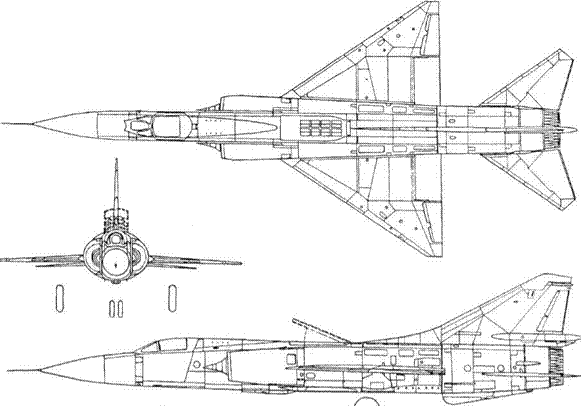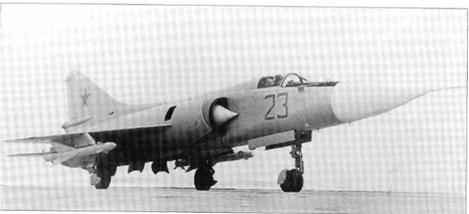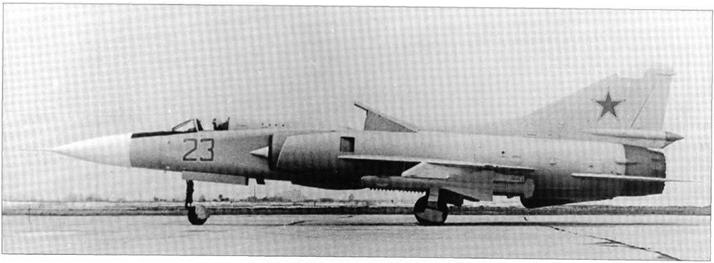1VKG-23PD, 23-01
Purpose: To evaluate a STOL fighter larger than the MiG-21.
Design Bureau: OKB-155 of A I Mikoyan.
By the 1960s, though the MiG-21 was going from strength to strength, the family of so – called heavy interceptors were being overtaken by the Ye-155 project (which became the MiG-25), and, by now facing severe competition from Sukhoi, there was an urgent need for a new tactical family more capable than the MiG-21. The new engine KB of K Khachaturov had produced an outstanding new engine, the R-27-300 (as before, the suffix -300 signified Factory No 300), an afterburning turbojet with maximum thrust of 7,800kg (17,196 Ib). This was intermediate between MiG-21 engines and those ofthe big interceptors. Mikoyan began studying future prospects for this engine in 1960. In 1964 he obtained an order for the 23-01 with a delta wing and a lift-engine bay, and in 1965 he was ordered to build the competing 23-11 with no
lift engines but a variable-geometry ‘swing wing’. Even though the 23-01 was managed by V A Mikoyan, second son of the General Constructor’s brother Anastas, President of the Supreme Soviet, it was considered in the OKB (correctly, as it turned out) to be a waste of time. This was because of the American fixation on the V G wing for the F-l 11. Despite this, the 23-01 was the subject of meticulous effort. The wing was like a scaled-up version ofthe blown-flap MiG-21, almost as large as a Ye-152, but with different main landing gear geometry. The tailplanes were of a new design, with sharp taper (almost becoming delta shape) and tips cropped at the Mach angle. The fuselage was totally new, with a nose designed to accommodate a powerful radar fire-control system (not fitted), lateral inlets with sliding centrebodies for the main engine, and a lift-engine bay between the main-engine ducts almost identical to that of the 23-31. The two RD-36-35 lift turbojets had a combined thrust of only 4,700kg (10,362 Ib),
and as this was a mere 29.5 per cent of the gross weight the 23-01 was never flown slower than 150km/h (93mph). Thus, it was not fitted with reaction-control jets. The landing gears were new, the large KT-133 main- wheels being housed upright in the sides of the fuselage and the nose unit having twin wheels, power steering and retracting not forwards but backwards. The KN-type seat was installed in a cockpit similar to that of contemporary MiG-21 s. Ostapenko began the brief factory test programme on 3rd April 1967. He was soon joined by Fedotov, but long before the 23-01 was completed Mikoyan had ceased to be interested in lift jets. With one eye on disinformation the number 23 was painted on the fuselage, an inoperative GSh-23L gun was fitted, and dummy Vympel R-23R and R-23T missiles were hung under the wings. The 23-01 was then briefly demonstrated at the big airshow at Moscow Do – modyedovo on 9th July 1967.
|
|
|

|
Dimensions |
||
|
Span |
7.72m |
25 ft m in |
|
Length (excl PVD boom) |
16.8m |
55 ft 1% in |
|
Wing area |
40.0m2 |
430.6ft2 |
|
Weights |
||
|
Empty |
12,020kg |
26,500 Ib |
|
Loaded |
16,000kg |
35,273 Ib |
Performance
Take-off run (light) 1 80-200 m 59I-656 ft
Landing run (with parabrake) 250m 820ft
Two views of 23-01, with dummy R-23
 guided missiles.
guided missiles.











